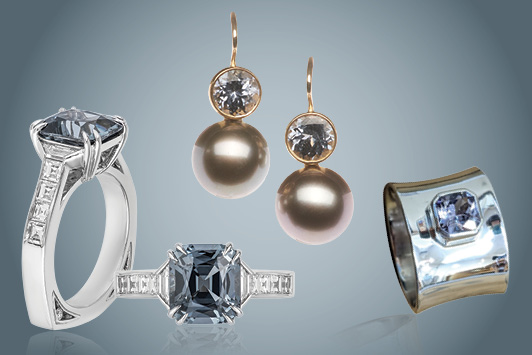
It would be fair to say that grey gemstones are having a moment. Their widespread appeal is likely the result of increasingly adventurous consumer tastes, as well as the stones’ unexpected charisma. Silvery grey has been among the most popular hair colors for younger women since 2018, a trend that gem suppliers say underscores the turn toward stones in this shade.
But while grey gems’ proliferation on the market may seem new, creative designers have been quietly adding them to their jewelry for some time.
Diana Widman of Chicago, Illinois, has been featuring grey gems in her collections for years. “I think it’s because I just love them,” she reflects. “I once had a collection of grey quartz set with diamonds, and earlier, I used grey industrial diamonds in some pieces.”
Fellow designer Michael Jakubowski, owner of Florida-based jeweler Gem Fanatic, made a splash in 2018 when his grey-spinel ring won the AGTA Spectrum Award for Platinum Innovation: Bridal. “To my knowledge, this is the first piece featuring a grey gemstone to win an award,” says Jakubowski, who started buying grey stones years ago as an oddity. “I wasn’t aware that pure grey stones were available aside from the occasional sapphire or tourmaline, let alone in any kind of quantity.” It was a couple of years into his fascination with grey spinel that he noticed jewels of this color becoming popular in the fashion world, he recalls.
What’s the reason they’re finding such favor? Custom jeweler Lisa Marie of Grass Valley, California, has some insights. “I’ve introduced many of my clients to grey stones,” she relates. “It appeals to the classic black-and-white palette lover, as well as to colored-stone enthusiasts. It’s a gem for everyone across the board.”
Cool and clean
The most sought-after grey gemstones are spinel, sapphire — including star sapphire — tourmaline, zircon and quartz. Other grey exotics like pearls, moonstone, chalcedony and chrysoberyl are also edging their way into designer goods.
Topping the list of grey must-haves is spinel, according to Brett Kosnar of Kosnar Gem Co. in Golden, Colorado. “Grey spinel is usually a relatively pure, clean material. Grey species as a whole tend to have fewer inclusions of a significant nature because they are lacking color chromophores that change their structure and chemistry,” he explains, referring to the accessory elements that give stones their color by absorbing light.
Besides grey spinel, which boasts high clarity, “silver-grey tourmaline, a rare material from Tanzania and Mozambique, is also exceptionally clean,” Kosnar reports. He’s found that the inclusions in these materials are similar to those of their colored counterparts, though “most of them tend to be cleaner.”
Some of the most coveted greys are sourced in the US. “Silver-grey sapphire from Montana has gained much popularity [because] it is typically untreated,” Kosnar says, though he adds that “flawless material is few and far between in Montana, and it will have slight color zoning.”
Widman, too, has noted the appeal of these Montana sapphires. They “are alluring on their own, [but also] make great companion stones for other colored gemstones set in jewelry,” she says.
In particular, grey star sapphires are enjoying a boost, and not just because of the new color mood, according to Kosnar. “Grey star sapphire tends to have the sharpest and most defined rays because of its higher light transmission. Colored star material by its nature will have less light transmission because color reduces the light return.”
The natural look
For the same reason high-clarity diamonds are cut to exploit their lucidity, clean grey stones are often polished into emerald cuts, hexagons or Asscher shapes to show off their clarity. Of course, they are also cut into radiant, cushion and other fancy shapes that appeal to a younger demographic.
As with spinel, the grey varieties of gems like tourmaline, sapphire, quartz and zircon are not treated, which is a bonus when marketing them, notes Yvonne L. Jiew, founder of wholesaler Rockstoc in New York. They are also relatively inexpensive compared with other colored stones, she says. Jiew predicts that “with the recent generation, this trend [of grey] will continue. Grey stones are incredibly huge in Europe, for example.”
Widman agrees that they have staying power. “Everyone seems to love the greys, because they are highly wearable, flattering, and they don’t scream; rather, they whisper,” she says.
Having kept grey stones on his radar for quite a while, Jakubowski adds, “I knew it would only be a matter of time until the rest of the world caught up.”
Image: Mogadam Photography/American Gem Trade AssociationArticle from the Rapaport Magazine - December 2019. To subscribe click here.